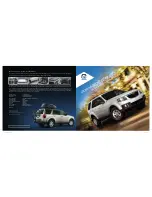
Black plate (331,1)
一
般
Model "A2440GE-A" EDITED: 2007/ 6/ 15
Driving an All-Wheel Drive
vehicle
WARNING
.
Always maintain a safe driving
speed according to the road and
weather conditions in order to
avoid having an accident on a
sharp turn, during sudden brak-
ing or under other similar condi-
tions.
.
Always use the utmost care in
driving
–
overconfidence be-
cause you are driving an All-
Wheel Drive vehicle could easily
lead to a serious accident.
&
All AWD models except
OUTBACK
All-Wheel Drive distributes the engine
power to all four wheels.
In normal driving, however, an AWD
vehicle operates almost the same as other
vehicles with front wheel drive. AWD
vehicles provide better traction when
driving on slippery, wet or snow-covered
roads and when moving out of mud, sand
or dirt. These vehicles, however, are not
designed for off road use. If you do this,
the vehicles may experience excessive
stress. AWD vehicles should be driven
only under the same conditions suitable
for ordinary front wheel drive vehicles.
For safety purpose as well as to avoid
damaging the AWD system, you should
keep the following tips in mind:
.
An AWD vehicle is better able to climb
steeper roads under snowy or slippery
conditions than a front wheel drive vehicle.
There is little difference in handling,
however, during extremely sharp turns or
sudden braking. Therefore, when driving
down a slope or turning corners, be sure
to reduce your speed and maintain an
ample distance from other vehicles.
.
Never attempt to drive through pools
and puddles, or roads flooded with water.
Water entering the engine air intake or the
exhaust pipe or water splashing onto
electrical parts may damage your vehicle
and may cause it to stall.
.
An AWD vehicle can be used to
traverse difficult areas covered with snow,
mud and slush, or sand and dirt. It is,
however, designed as an all-road vehicle
and not as an all-terrain vehicle. For this
reason, an AWD vehicle should be
handled with as much care as an ordinary
passenger vehicle.
.
Always check your brakes for effec-
tiveness immediately after driving in sand,
mud or puddle. Do this by driving slowly
and stepping on the brake pedal. Repeat
that process several times to dry out the
brake discs and brake pads.
.
When replacing a tire, make sure you
use only the same size, circumference,
construction, brand, speed symbol and
load index as the original tires listed on the
tire placard. Using other sizes, circumfer-
ences or construction may result in severe
mechanical damage to the drive train of
your vehicle and may affect ride, handling,
braking, speedometer/odometer calibra-
tion, and clearance between the body
and tires. It also may be dangerous and
lead to loss of vehicle control.
.
Always check the cold tire pressure
before starting to drive. The recom-
mended tire pressure is provided on the
Driving tips
8-5
–
CONTINUED
–
8
















































